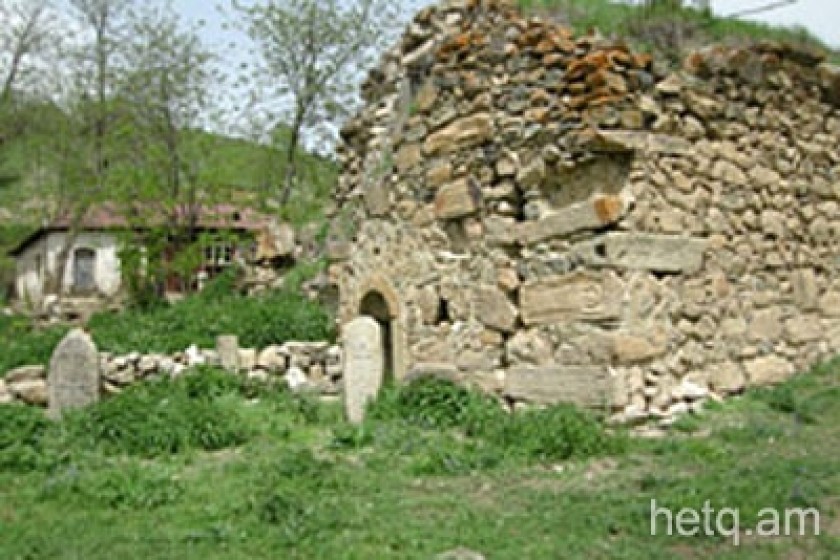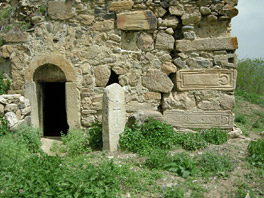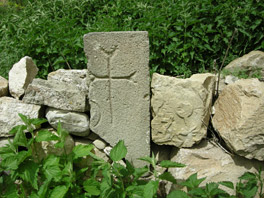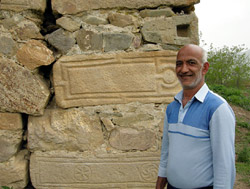
In Kashatagh the conditions necessary for progress do not exist
Shalua is one of the few villages in Kashatagh where the Azeris were never able to destroy the local church.
The village is named after the river of the same name on whose banks it is located. In the center of the village is the church at the entrance of which the villagers have placed the broken remnants of stone-crosses found in the area and pieces of the church wall that have fallen down. The Azeris would use stones from the church as foundations for their houses and stable and as walls. At the base of a wall of a nearby house stones from the church can be seen.
According to village resident Samvel Mkrtchyan, “ A few years ago these stone crosses and other stones were placed in the church courtyard but they're scattered throughout this area.
” In his book, “Armenian Cultural Monuments Located in in Regions Annexed by Soviet Azerbaijan”, Samvel Karapetyan, who has researched Armenian edifices in the liberated territories, writes that all the villages along the length of the river, including Shalua, were populated by Armenians since ancient times but that after the second half of the 18 th century Armenians left the regions and Kurds began to move in.
 |
 |
Karapetyan believes the church was built sometimes during the 17 th century. Today, the villagers have cleaned-up the church grounds and consider it a place of worship.
 Six years ago Samvel Mkrtchyan and his family moved here fromYerevan. His wife is the school principal in Shalua. Samvel relates that, “ There was no work inYerevan for my wife who is a teacher. When we heard about the need for teachers here we came. My daughter is inYerevan studying. On of my sons starts his military service on June 3 rd . My youngest boy is in the sixth grade in school.”
Six years ago Samvel Mkrtchyan and his family moved here fromYerevan. His wife is the school principal in Shalua. Samvel relates that, “ There was no work inYerevan for my wife who is a teacher. When we heard about the need for teachers here we came. My daughter is inYerevan studying. On of my sons starts his military service on June 3 rd . My youngest boy is in the sixth grade in school.”
Shalua is famous for the small hydroelectric power plant that was built along the river years ago. During those times when it was partially operational it provided the village with electricity. For the last few years the plant was been shut down. One of the villagers stated that a piece of equipment had to be sent to Sisian for repair. A young resident chimed in that, “ the one kilometer canal needs constant cleaning and that the pipes often freeze-up during the winter and burst. Thus, there's no water to power the plant.”
Samvel continues, “ Seven years ago there were 24 families in Shalua; today 11 remain. The number of children attending school is decreasing. Many in the above lying villages send their kids to the city for their schooling where they live with relatives. Two children from Verishen are sent to school here. We have to think about what to do. We only need to resolve a few outstanding issues and much will change. Since there's no means of transportation we can't get to Berdzor to buy food. When my wife's father and mother passed away we never received the news. She never attended their funerals. We bring all our essentials from Berdzor. We received a telephone call from the Military service committee telling us that our son should report for duty. But how is he supposed to get there? The army isn't interested in our problems. Somehow we'll have to find a way.”
The villagers of Kashatagh don't protest the fact that they are poor or have nothing to eat. Rather, they complain that conditions necessary for progress do not exist. Samvel owns 16 farm animals, 8 of which are dairy cows. “ We take the cheese we make to Berdzor and barter it for clothes for the children. It costs us 600 dram to make the exchange while the same cheese sells for 1200-1500 dram. The situation with meat is the same. If we could sell our cheese at market prices our situation would greatly improve,” Samvel concludes in a convincing tone of voice.
This year alone 4 residents from this tiny village have been called-up for military service.
 Videos
Videos Photos
Photos




Write a comment